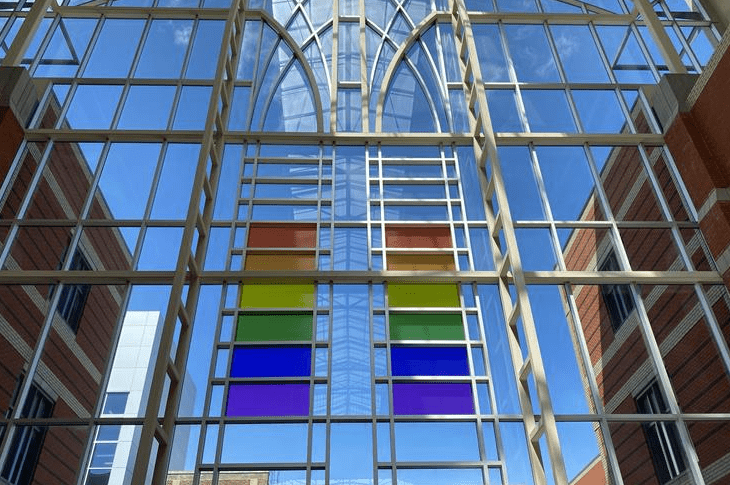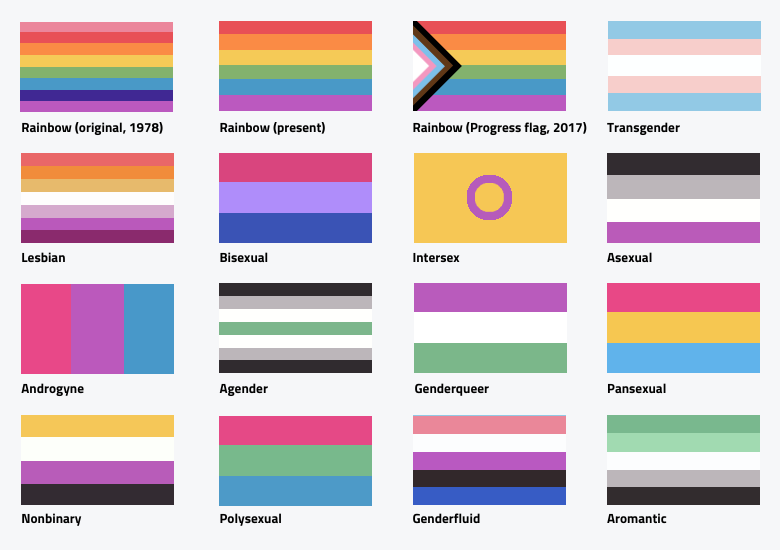Pride 101

June is Pride Month — our first of three annual pride celebrations — and we’re celebrating #HereAtSAIT.
If you’re looking for a quick refresher on why Pride is celebrated, what 2SLGBTQ+ stands for and how to get involved, we’ve got you!
An important acronym: 2SLGBTQ+
It’s a lot of letters, but each one is important. This acronym does its best to reflect all groups represented during Pride celebrations. In order of appearance:
2S (Two-spirit): A term used within Indigenous communities to refer to someone who identifies with both a masculine and feminine spirit. Being two-spirit can be mean many things to different individuals, and it may reflect gender identity, gender variance, or sexual orientation or preference.
L (Lesbian): Refers to cis-or-transgender women who are attracted to other women.
G (Gay): Refers to cis-or-transgender men who are attracted to other men. Sometimes, gay also refers more broadly to same-sex attraction.
B (Bisexual, Bi): Refers to cisgender or transgender people who are attracted to both people of their own gender and to genders different from their own.
T (Transgender, Trans): Refers to individuals who do not identify with the gender identity that they were assigned at birth. Gender identity refers to a person’s internal knowledge of their gender — for example, if you see yourself as a man or a woman. Sex is assigned at birth based on a person’s reproductive system and other physical characteristics — but it has no correspondence with gender identity. When sex and gender identity match, we say that a person is cisgender.
Q (Queer and Questioning): Queer is an umbrella term that some choose to use to describe a sexual identity other than heterosexual, or a gender identity other than cisgender, while questioning broadly includes those who are exploring or discovering their sexual and gender identities.
+ (and more!): There are so many groups represented at Pride every year, and we celebrate all gender identities and forms of sexual expression. The plus-sign simply means that, even if a group is not identified with one of the letters above, their identity is wholly valid.
Three pride celebrations — why?
Pride is celebrated internationally in June in recognition the Stonewall uprising (also known as the Stonewall riots).
Pride history
On June 28, 1969, in Greenwich Village in New York City, police raided a popular gathering place for the 2SLGBTQ+ community: the Stonewall Inn. Employees and patrons were harassed, but this time the community stood up for their rights, igniting the 2SLGBTQ+ rights movement.
2SLGBTQ+ people face many challenges. Even in places where their rights are recognized, this community faces discrimination, bias and underrepresentation. There is so much history here and, if it interests you, consider reading further on Stonewall or the 2SLGBTQ+ liberation movements in Canada.
Pride is celebrated locally at the end of August and September. In Calgary, this is all about weather. Enjoy the celebrations happening across Canada and the world through June, but show up again for Calgary’s sunny parade and festival on Aug. 31 and Sept. 1.
Because October is internationally recognized as LGBT History Month and October 11 is National Coming Out Day, Pride is celebrated at SAIT during the second week of October. During our Pride Week, we recognize and celebrate the very special 2SLGBTQ+ community of students and employees while classes are in session. We’ll share more about SAIT Pride and events to look forward to later in the summer.
Raise the flags!
Flags are symbols of community, unity and visibility. Over the years, the Pride flag has evolved to promote greater inclusion and recognize the many 2SLGBTQ+ communities.
Often, rainbows are synonymous with pride. But did you know the first pride flag — debuted in 1978 — had a line of hot pink at the top and slightly different colour shades, including teal? These colours didn’t last long once the flag hit production, as these colours were not readily available in shops.
In 2018, a designer named Daniel Guasar introduced a new design known as the progress flag. While still including the original rainbow colours, the progress flag also includes a chevron pattern representing marginalized people of colour, trans individuals and recognizing and remembering those living with HIV/AIDS.
You may also be familiar with other flags that exist today to represent more specific groups within the 2SLGBTQ+ community.

Pride at SAIT
SAIT is a diverse campus, and we are committed to providing an inclusive place to work and study. No matter your sexual orientation or gender identity, we want our campus to be a safe environment for you to be your truest self.
For information about changing your preferred name, attending pride events or being a good ally, check out the Pride at SAIT committee. This awesome group organizes events, does community outreach and advises on ways to eliminate heterosexism, transphobia, homophobia and gender identity oppression within the SAIT community. If you’re a student passionate about doing the same, you can get involved through the Saitsa Pride+ Club.
We hold events and training opportunities year-round to spread awareness of 2SLGBTQ+ themes and barriers, to build community and to help allies get involved.
Some upcoming events are:
Upcoming events

Oki, Âba wathtech, Danit'ada, Tawnshi, Hello.
SAIT is located on the traditional territories of the Niitsitapi (Blackfoot) and the people of Treaty 7 which includes the Siksika, the Piikani, the Kainai, the Tsuut’ina and the Îyârhe Nakoda of Bearspaw, Chiniki and Goodstoney.
We are situated in an area the Blackfoot tribes traditionally called Moh’kinsstis, where the Bow River meets the Elbow River. We now call it the city of Calgary, which is also home to the Métis Nation of Alberta.